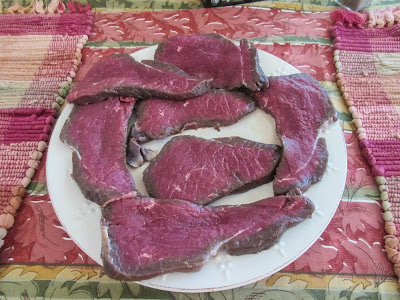The eland is an African antelope. It was high on the list of animals I wanted to see in Africa last year and we saw one on our last day in Nairobi National Park as we were leaving. It is one of the largest African antelopes, looks a little ungainly and ugly, and has been domesticated for meat production in some areas of the world.
Anshu Pathak of Exotic Meat Market located some domestic eland raised in Hawaii and made some eland meat available. I got a 3.9 pound roast that was so large that it gave me an opportunity to experiment by cooking it in different ways. There is virtually no fat so I was determined not to overcook it.
 |
| 3.9 pound eland roast. |
First, I sliced part of the roast into thin slices and coated the slices in olive oil, then added salt and pepper.
Next, I put two slices in a frying pan with some butter and several eggs from a friend of mine who raises chickens. I cooked the meat medium rare and ate it with bites of over-easy eggs. The meat is very mild, has none of the gamy taste that so often is found in antelope and it was quite tender.
 |
| Fried eland with eggs. |
 |
| Note the pink meat in the cut pieces. |
I put the rest of the thin slices onto the outdoor gas grill on high and cooked each side only for a minute or two. I sampled a slice or two at the same time I ate the fried slices. I liked the grilled slices much better: they were more moist and had a grilled flavor that really added to the flavor. I put the balance of the grilled slices into the refrigerator for some later meals.
 |
| Grilled eland. |
I set aside two slabs of the roast to cook sous vide, one for a relatively snort period of time and the other much longer.
I cooked both at 57 degrees centigrade for medium rare. For the portion to be cooked for a shorter time, I added thyme, rosemary, roasted garlic slices, olive oil, salt and pepper and I cooked it for 3 and a half hours. The rosemary and garlic taste had diffused through the meat and I was surprised to find the meat a little stringy, more so than the fried or grilled meat. It was good, but I preferred the flavor, texture and juiciness of the grilled meat.
 |
| Sous vide cooked eland with rosemary and garlic. |
The other slab was cooked sous vide with ground ginger, maple sugar, orange peel, mandarin orange vinegar, olive oil, salt and pepper. It was cooked for 9 hours and 45 minutes, almost three times longer. The texture of the meat was very mushy which detracted from it a lot. I liked the sweetness and would have liked more maple sugar and less ginger. The sweetness was a nice addition and I think I would have liked it much more without the mushiness.
 |
| Sous vide eland with maple sugar and ginger. |
My favorite cooking method was by far the grilling. So the last bit of eland I cut into thicker slices and cooked it on the grill, coating it in olive oil, with salt and pepper. I cooked it rare. This was the best. It had a nice grilled taste and was very moist and juicy. It reminded me a lot of seared tuna and I wish I'd had some wasabi and soy sauce. I think that would be a wonderful combination.
 |
| Thicker slices of eland cooked on the grill. |
 |
| Nice and rare. |
For the leftovers, I made a large salad for lunch each of the next three days, with red leaf lettuce, chopped sweet onion, chopped orange and red peppers, tomatoes and avocados. Then I heated several slices of eland up in the microwave, cut it into slices and added it to the salad. I used blue cheese dressing for one salad and rosemary infused olive oil for the other two salads. It was amazing. Very lean, very tender with a nice different texture than the other ingredients.
 |
| Grilled eland added to a salad. |
It was very fun to experiment by cooking the eland in different ways. I wouldn't hesitate to cut an eland roast into thin grilling slices again, trying some with wasabi and soy sauce, some just salt and peppered off the grill and some added to salads.


















































































